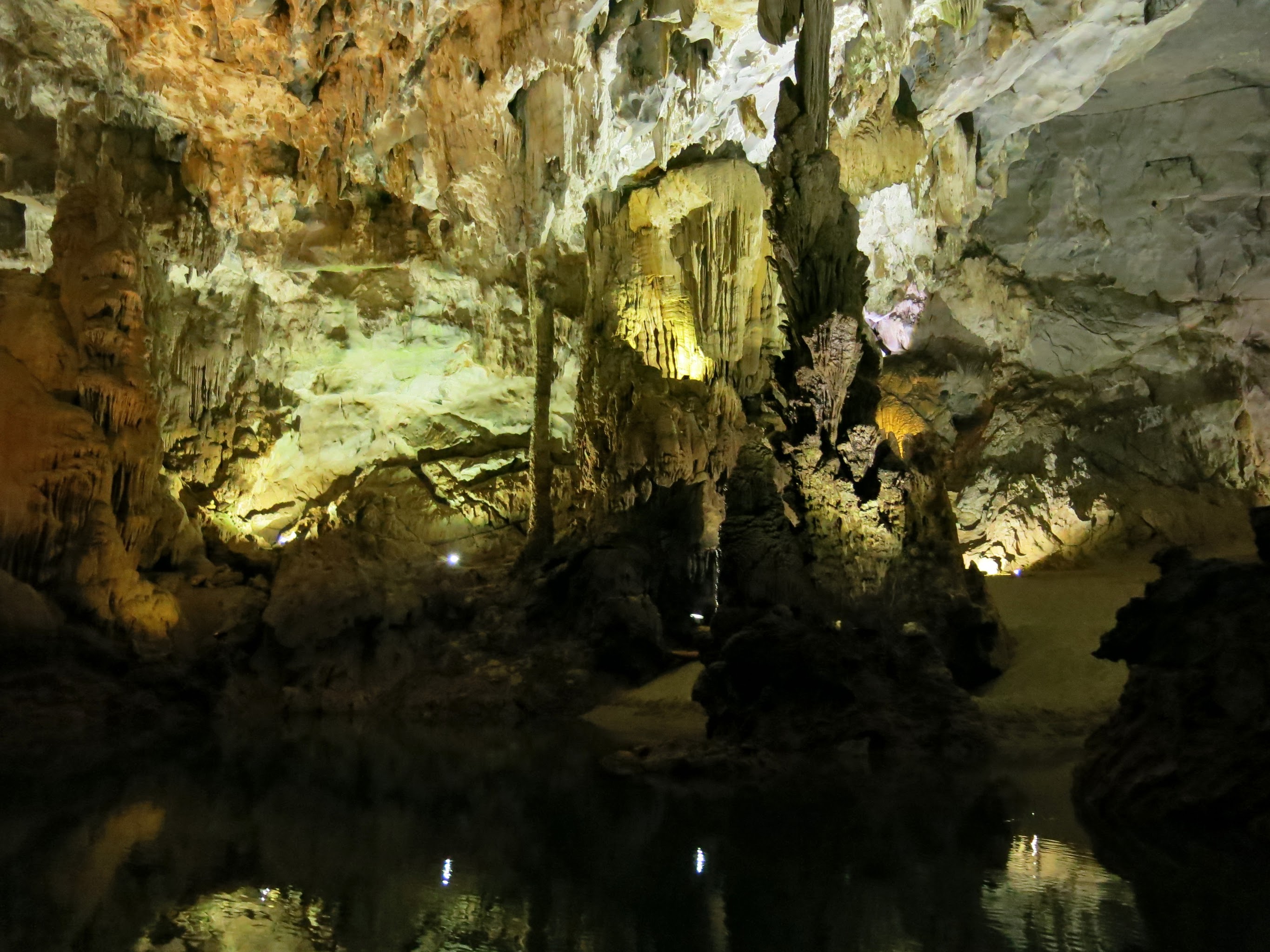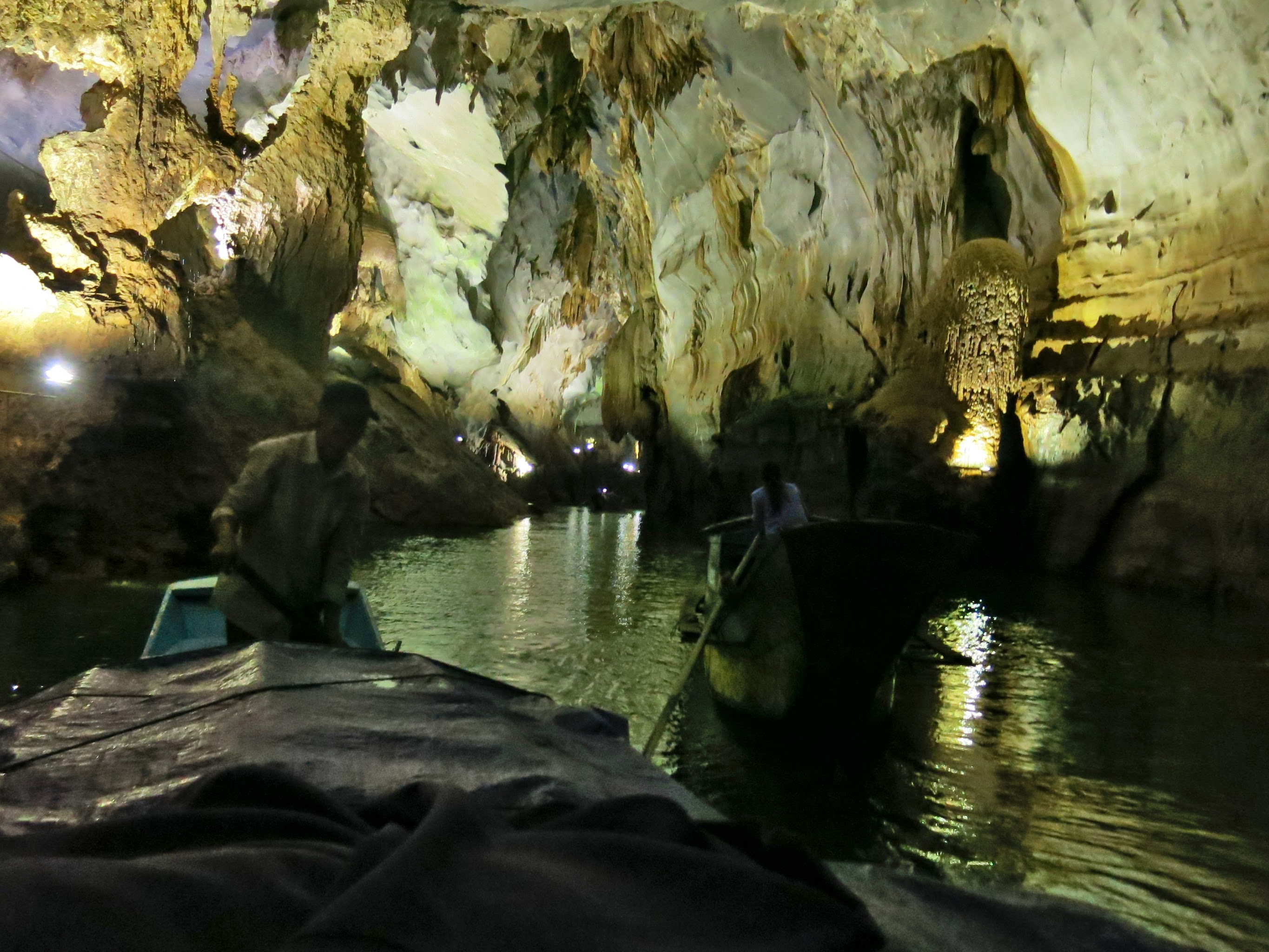Our stay in Hue had restored us. Our health well in hand, we cast our gaze outward. Where else in this wonderful country should we explore? We consulted maps and guides, asked around, and settled on the not-too-far region of recently discovered caves called Phong Nha. We purchased bus tickets at a travel office ticket counter (so old-fashioned!), and the next day the bus came to our hotel to pick us up. And then to the next hotel, and then the next, and then the next. And then we were all on our way.

Phong Nha is a funny area. The cave which bears the region's name has its own fork of a river. A ridge runs along the river, and when the river branches, one side flows right into the hillside. A giant open gash that could serve as an airplane hanger announces to the whole valley, "here is a cave!". The area was listed as a UNESCO site in 2003. And rightly so: the town is quaint, the region is scenic in an agrarian way, and boats can travel up the river and right into the cave. The trip seems like an amusement park ride, though the cave is filled with formations that would beggar the imagination of Disney Imagineers.

The funniest part is that in 2005, up in the hills outside of town, another giant cave was uncovered. Just a few years after the UNESCO recognition. This new cave, the "Carlsbad" of Vietnam, is enormous and filled with even more spectacular mineral wonders. Discovered not long ago, it already has a snack bar and is visited by bus fulls of tourists. With the English name "Paradise Cave" you might expect it to let visitors down, but this cave earns the name.

But wait. The actual funniest part is that a few years later in 2009, British explorers found that a remote cave in the region known to a few locals was in fact the largest cave in the world.
So, caves are popping up all over the place in Phong Nha. Insofar as voids can pop.
That last cave, the largest one in the world, is named Sơn Đoòng. It is remote, and to visit you must go through a tourism group called Oxalis. They appear to have a monopoly on tourist access to the cave, limiting the number of visitors and charging over 3,000$ for the trip. This in a country where an after work beer costs 25 US pennies. It is more money than a well off Vietnamese will see in a year. Priced in terms of average yearly income, it would be 100,000$ for us. We could never afford to go. The world's largest cave is Vietnamese and the Vietnamese can't go. According to a local, who with a full-sized sport motorbike must have been among the Vietnamese elite, no Vietnamese tourists have ever visited the cave.

Phong Nha town expects tourism of course, but the area was so remote to start with that the infrastructure to support the visitors, the hostels and bike rental places and so on, all have the feel of a flimsy concrete flash mob. A floor was added to one building during our short stay. The rice patties on either side of the only street that matters seem to be placidly waiting for this all to blow over.

Our hotel in Phong Nha made a curious choice of font for their street sign: that horror film font where blood drips from the letters. The staff were not ghouls, and the place not horror movie themed. Far from it. Most of our contact was with a cheerful teenage girl. We always seemed to be rousing her from sleep, though the times we chose to have needs were quite pedestrian. Afternoon and so on. But still she was cheerful. Her English improved as she woke up.
"Is this your child?"
The biggest little toddler we had seen in Vietnam wandered the lobby, less well looked after than most toddlers, and that is really saying something.

The lobby was a typical Vietnamese hotel lobby. It was comfortable with couches and breakfast was served there in the morning. Pictures of family and friends were on the walls and there were guest books and so on. But the lobby blended seamlessly from home to garage where scooters with their oil stains and noise were stored. And then right out onto the sidewalk and finally out to a major highway. The noise was terrible, and the jarring effect of having the trappings of comfort so near automotive hurly burly was made all the more pointed as the kid weaved around on his chubby little legs.
"Oh no", giggle, "that is Viet. His parents are in Korea."
"And you are watching him while they are gone?"
"The have a divorce, and they send Viet home".
"They got divorced, and they both still live in Korea?"
She nodded.
Hmm. "He is enormous!"
"Oh yes, he had good Korean milk. In Vietnam we have only Chinese milk. It is not very good."
Little Viet, named I can only imagine by parents thinking of home, was a displaced fragment of a family wandering in a town under constant construction.

Did you ever wonder how life must be for long haul flight crew? Sleeping in those little places on the plane so they will be fresh for the too soon sunrise that waits over the Atlantic? And if home for them feels like home really, or if it is just another timezone to be inhabited for a certain duration?
The girl, I think she was "Mai" seemed to me like a stewardess, and Phong Nha her airport. The scenery was tranquil, but all around us society was boiling over.
























































